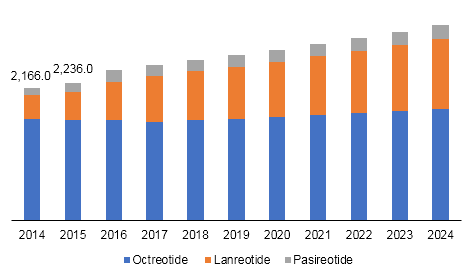
Somatostatin Analogs Market Size and Forecast By Type (Octreotide, Lanreotide, Pasireotide) By Indication (Acromegaly, Neuroendocrine Tumor (NET)) And Trend Analysis, 2014 - 2024
- Published: April, 2018
- Format: Electronic (PDF)
- Number of pages: 60
- Industry: Pharmaceuticals
Industry Insights
The global somatostatin analogs market size was valued at USD 2,166 million in 2014 and is expected to witness a significant growth, pertaining to the rise in the prevalence of acromegaly and neuroendocrine tumors coupled with the rising investments in R&D activities.
Somatostatin Analogs market revenue, by type, 2014 - 2024 (USD Million)

Somatostatin analogs are used as first line of treatment in conditions such as acromegaly, carcinoid syndrome, neuroendocrine tumor, Cushing syndrome and other related diseases. Somatostatin analogues work by inhibiting production of growth hormones and serotonin. Reducing the level of growth hormone in the body controls the symptoms of acromegaly and associated hormonal conditions.
Octreotide brand name sandostatin is the one of the most researched molecule for the treatment of acromegaly, worldwide. Sandostatin is synthetic form of naturally occurring hormone called as somatostatin. Somatostatin analogs (octreotide) work by inhibiting the production of hormones, mainly GH and serotonin. Inhibiting growth these hormones helps to governor the skin flushing and diarrhea
Segmentation by analog type
• Octreotide
• Lanreotide
• Pasireotide
The octreotide segment occupied more than 75% of the revenue share in 2014 and is expected to grow over the forecast period on account of rising number of patients diagnosed with neuroendocrine tumor (NET) and related diseases. Octreotide is marketed as Sandostatin and Sandostatin LAR in global market. It reduces growth hormone (GH) secretion, Vasoactive Intestinal Peptide (VIP), gastrin secretion, glucagon secretion, serotonin release and pancreatic polypeptide. In case of acromegaly, the analog decreases IFG-1 secretion and growth hormone secretion. It also reduces LH response to GnRH and suppresses splanchnic blood flow. Bioavailability of analog is IM, 60% and SC, 100%. The peak plasma time for octreotide is IV, immediately after injection, IM, 60 min, PO, 90-120 min, SC, 15-30 min. Sandostatin is administered as a subcutaneous injection. The dose interval varies from patient to patient.
Lanreotide is a drug used in management and treatment of acromegaly. It is also administered in the treatment of symptoms caused by carcinoid syndrome. The molecule is long acting somatostatin analog similar to octreotide. The sequence for lanreotide is H-D-2Nal-Cys(1)-Tyr-D-Trp-Lys-Val-Cys(1)-Thr-NH2. The drug is marketed under the brand name Somatuline and is manufactured by Ipsen.
Segmentation by indication
• Acromegaly
• Neuroendocrine Tumor (NET)
• Others
The use of somatostatin analogs in the neuroendocrine tumor (NET) segment occupied more than 49% of the revenue share in 2014 and is expected to grow over the forecast period on account of the rise in the number of patients diagnosed with neuroendocrine tumor. An estimated 11,500 – 12,000 individuals are diagnosed with carcinoid syndrome in U.S each year. The incidence rate of neuroendocrine tumor is increasing partly owing to the growing awareness of the disease and increased accurateness of diagnosis. NET is characterized by fluctuating blood sugar level and skin flushing. The incidence rate of neuroendocrine tumor has increased fivefold in in the U.S. in last three decades, with 5 of everyone lakh individuals are diagnosed with neuroendocrine tumor annually, which is expected to provide lucrative opportunities for the market growth. Incidence rate varies geography to geography.
Novartis AG held Live Twitter Chat show on world acromegaly day to spread the awareness among the medical practitioners and patients. Increased awareness is expected to impact on early diagnosis of the condition. Thus, increasing awareness campaigns by various organizations such as Pituitary Foundation and Pituitary Association Australia may lead to increase in pool of patient through early diagnosis which in turn may have positive impact on the market growth. Lack of awareness among the frontline medical practitioners may hamper the penetration of drugs in the market over the forecast period.
Rise in the research and development and launch of novel drug therapies are the factors driving the growth of somatostatin analogs used for the treatment of acromegaly over the forecast period. For instance, pasireitide (signifor) is gaining momentum owing to the better efficacy compared to octreotide (sandostatin). Furthermore, various drugs are in phase II and phase III of clinical trials which are expected to heat the market in coming years, thus, may lead to increase in penetration of drugs in emerging economies. For instance, somatuline is in phase III of clinical trial for treatment of acromegaly in China. Also, AMRYT Pharma’s drug AP102 is in early stage of development for the treatment of acromegaly, thus increased in research and development is projected to increase in penetration of novel therapies in merging market in the near future, which in turn may boost the market for acromegaly.
Competitive landscape
The somatostatin analogs market is competitive and fragmented in nature with the existence of a major somatostatin analogs suppliers and a huge number of small players. As well. Major players include Novartis AG, Peptron, Chiasma, Inc., Ipsen Biopharmaceuticals, Inc. and Sun Pharma Advanced Research Company Ltd. The leading players in the market are growing their scope by increasing their focus on the new technologies, innovation and research and development activities to increase the efficiency of somatostatin analogs. The major companies are focused on improving brand positioning by constant innovations, product differentiation and introducing new drugs for the treatment of non-operable tumors. They are taking major initiatives to introduce clinical trials for testing of new somatostatin analogs.

Choose License Type
- World's largest premium report database
- Transparent pre & post sale customer engagement model
- Unparalleled flexibility in terms of rendering services
- Safe & secure web experience
- 24*5 Research support service
